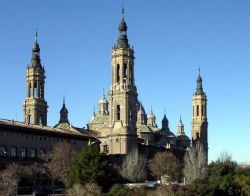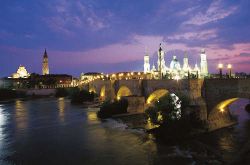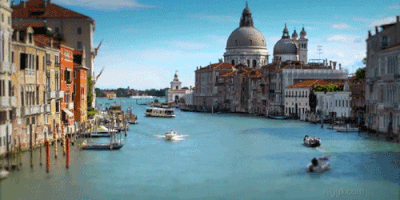Common description
The capital of Aragon, Zaragoza - is a large, modern city, the sixth largest city in Spain with a population of half a million people, with developed industry, university. The past - far and relatively recent - is closely intertwined with the present day, forming an irreversible link between the times and the memories of people of different generations.
The first settlements of the Iberian tribes, spoken in the ancient Aragonese dialect, appeared in the Ebro valley long before the new era, and the Pyrenees served as an obstacle to them from foreign conquerors. In the time of the Iberians on the site of Zaragoza there was a small settlement called Saldub.
Then came the troops of the Roman Emperor Augustus. Subduing the Aragonese desperately, the Romans founded in 27 BC. on the site of what is now Zaragoza is the military settlement of Caesarea Augusta ("the city of Emperor Augustus"), which soon became one of the most prosperous cities in Iberia. Until now, in Zaragoza can be seen preserved fragments of the fortress walls of the Roman era.The first traces of Christianity in Zaragoza belong to the IV century. However, there is a legend that about 40 m in Zaragoza visited and preached the Word of Christ the Apostle Jacob.
After the Romans, Zaragoza possessed time. In 716, the city was taken over by the Arabs under the leadership of Musa Ibn Nusair and was called Medinat Saragusta. During the Moors, the city competed in beauty and wealth with Cordova, Toledo and Merida. It is said that once Zaragoza was surrounded by fortress walls made of white stone, and it was called "white stone" or "White City", like Moscow.
In 1118, during the time of the Reconquest, King Alfonso I of Aragon expelled the Moors from Zaragoza and from that time, from the beginning of the XII to the end of the XV century. Zaragoza was the residence of the Aragonese kings, but subsequently, after reunification from Aragon and Castile, lost all its rights and privileges.
In Zaragoza, King Ferdinand and Queen Isabella Catholic were married, during which time the expulsion of the Moors from Spain and open America was completed.
During the Napoleonic wars, Zaragoza became famous throughout Europe with unprecedented resistance to French troops. The siege of Zaragoza in 1808 - 1809 became the most striking page in the history of the struggle of the Spaniards with Napoleon. As a reminder of the courage of the Aragonese is now a monument to 54 thousand dead residents of Zaragoza and the surrounding area, to withstand the siege of Napoleonic troops in two months. Even with the destruction of the defensive wall, the French were forced to fight for each house, and were able to reach only the city center, without risking the continuation of the offensive. Since then, Zaragoza has received the title of "Always Heroic", and its military flag has been decorated with the honorary award of the Spanish kings.
Zaragoza is the city of the great Goya. Here he was born, here he created his first masterpieces.
In the architectural form of Zaragoza is dominated by low massive buildings without decoration, often connected by long columns, invisible gray colors. And only in the ancient cathedral, which was built for four centuries, combined the wealth and brightness of the imaginary and real world of the Aragonese. But even here, the numerous chapels and chapels do not strike the edge of splendor and sophistication inherent in the cathedrals of Seville and Toledo.
The Old Town is located between Bruel Park and Alhaferia Palace. Its center is the Cathedral of Zaragoza Nuestra Senora del Pilar. Legend has it that the cathedral was built on the very spot where the miraculous phenomenon of Our Lady (Blessed Virgin) Apostle James happened in 40 m. In the VIII century. a Christian temple was built here. Later the city was conquered by the Moors. After its conquest by the Spaniards, the cathedral was rebuilt.
The existing building is quite late, it was built in 1515. The facades of the cathedral are decorated in Baroque style. The interiors of the temple are extremely ornate, here you can see bronze, different marble varieties and rare jasper for Spain. The remarkable retabl was executed in 1509 by sculptor Damiano Formenti. The vault of the cathedral was painted by young Francisco Goya.
The first settlements of the Iberian tribes, spoken in the ancient Aragonese dialect, appeared in the Ebro valley long before the new era, and the Pyrenees served as an obstacle to them from foreign conquerors. In the time of the Iberians on the site of Zaragoza there was a small settlement called Saldub.
Then came the troops of the Roman Emperor Augustus. Subduing the Aragonese desperately, the Romans founded in 27 BC. on the site of what is now Zaragoza is the military settlement of Caesarea Augusta ("the city of Emperor Augustus"), which soon became one of the most prosperous cities in Iberia. Until now, in Zaragoza can be seen preserved fragments of the fortress walls of the Roman era.The first traces of Christianity in Zaragoza belong to the IV century. However, there is a legend that about 40 m in Zaragoza visited and preached the Word of Christ the Apostle Jacob.
After the Romans, Zaragoza possessed time. In 716, the city was taken over by the Arabs under the leadership of Musa Ibn Nusair and was called Medinat Saragusta. During the Moors, the city competed in beauty and wealth with Cordova, Toledo and Merida. It is said that once Zaragoza was surrounded by fortress walls made of white stone, and it was called "white stone" or "White City", like Moscow.
In 1118, during the time of the Reconquest, King Alfonso I of Aragon expelled the Moors from Zaragoza and from that time, from the beginning of the XII to the end of the XV century. Zaragoza was the residence of the Aragonese kings, but subsequently, after reunification from Aragon and Castile, lost all its rights and privileges.
In Zaragoza, King Ferdinand and Queen Isabella Catholic were married, during which time the expulsion of the Moors from Spain and open America was completed.
During the Napoleonic wars, Zaragoza became famous throughout Europe with unprecedented resistance to French troops. The siege of Zaragoza in 1808 - 1809 became the most striking page in the history of the struggle of the Spaniards with Napoleon. As a reminder of the courage of the Aragonese is now a monument to 54 thousand dead residents of Zaragoza and the surrounding area, to withstand the siege of Napoleonic troops in two months. Even with the destruction of the defensive wall, the French were forced to fight for each house, and were able to reach only the city center, without risking the continuation of the offensive. Since then, Zaragoza has received the title of "Always Heroic", and its military flag has been decorated with the honorary award of the Spanish kings.
Zaragoza is the city of the great Goya. Here he was born, here he created his first masterpieces.
In the architectural form of Zaragoza is dominated by low massive buildings without decoration, often connected by long columns, invisible gray colors. And only in the ancient cathedral, which was built for four centuries, combined the wealth and brightness of the imaginary and real world of the Aragonese. But even here, the numerous chapels and chapels do not strike the edge of splendor and sophistication inherent in the cathedrals of Seville and Toledo.
The Old Town is located between Bruel Park and Alhaferia Palace. Its center is the Cathedral of Zaragoza Nuestra Senora del Pilar. Legend has it that the cathedral was built on the very spot where the miraculous phenomenon of Our Lady (Blessed Virgin) Apostle James happened in 40 m. In the VIII century. a Christian temple was built here. Later the city was conquered by the Moors. After its conquest by the Spaniards, the cathedral was rebuilt.
The existing building is quite late, it was built in 1515. The facades of the cathedral are decorated in Baroque style. The interiors of the temple are extremely ornate, here you can see bronze, different marble varieties and rare jasper for Spain. The remarkable retabl was executed in 1509 by sculptor Damiano Formenti. The vault of the cathedral was painted by young Francisco Goya.
Zaragoza on map
+ 15°C





